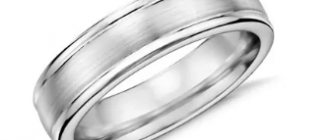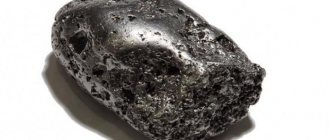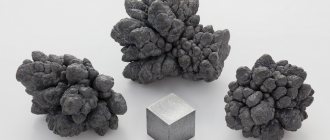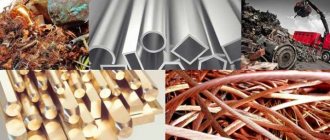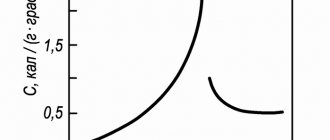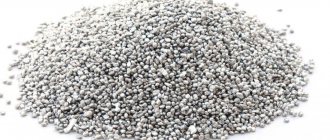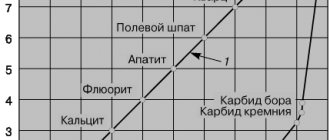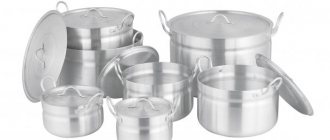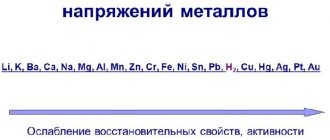What are alkali metals?
Alkali metals have the electronic configuration of the outer energy level: ns1 , the outer energy level contains 1 s-electron.
The typical oxidation state of alkali metals in compounds is +1 .
They are located immediately behind the inert gases, so the peculiarity of the structure of alkali metal atoms is that they contain one electron at the outer energy level: their electronic configuration is ns1.
The valence electrons of alkali metals can be easily removed because it is energetically favorable for the atom to give up an electron and acquire a noble gas configuration.
Therefore, all alkali metals are characterized by reducing properties.
This is confirmed by the low values of their ionization potentials (the ionization potential of the cesium atom is the lowest) and electronegativity (EO).
Single charged cations
In most compounds, alkali metals are present in the form of singly charged cations.
However, there are also compounds where alkali metals are represented by anions (see Alkalides).
In nature
On our planet, lithium is found only in compounds. It is found in seawater in an amount of approximately 0.17 mg/l and in highly saline lakes. It is also found in the upper layers of the earth's crust in an amount of 21 g/t.
Lithium is mainly found in lepidolites, spodumenes, petalites, lithiophilites, amblygonites and zinnwaldites. It occurs together with rare elements in pegmatites and ongonites. It can form independent minerals, or it can replace potassium in them.
Metal is also present in space, mainly in giant stars. A huge amount of lithium is found in the Thorne-Zytkow object, which consists of a red giant with a neutron star inside.
atomic and physical properties of alkali metals
| Atomic number | Name, symbol | Number of natural isotopes | Atomic mass | Ionization energy, kJ mol−1 | Electron affinity, kJ mol −1 | EO | Δ H diss , kJ mol −1 | Metal. radius, nm | Ionic radius (CN 6), nm | t pl ,°C | t kip ,°C | Density, g/cm³ | Δ Hpl , kJ mol −1 | Δ H kip, kJ mol −1 | Δ H arr , kJ mol −1 |
| 3 | Lithium Li | 2 | 6,941(2) | 520,2 | 59,8 | 0,98 | 106,5 | 0,152 | 0,076 | 180,6 | 1342 | 0,534 | 2,93 | 148 | 162 |
| 11 | Sodium Na | 1 | 22,989768(6) | 495,8 | 52,9 | 0,99 | 73,6 | 0,186 | 0,102 | 97,8 | 883 | 0,968 | 2,64 | 99 | 108 |
| 19 | Potassium K | 2+1 a | 39,0983(1) | 418,8 | 46,36 | 0,82 | 57,3 | 0,227 | 0,138 | 63,07 | 759 | 0,856 | 2,39 | 79 | 89,6 |
| 37 | Rubidium Rb | 1+1 a | 85,4687(3) | 403,0 | 46,88 | 0,82 | 45,6 | 0,248 | 0,152 | 39,5 | 688 | 1,532 | 2,20 | 76 | 82 |
| 55 | Cesium Cs | 1 | 132,90543(5) | 375,7 | 45,5 | 0,79 | 44,77 | 0,265 | 0,167 | 28,4 | 671 | 1,90 | 2,09 | 67 | 78,2 |
| 87 | France Fr | 2a | (223) | 380 | (44,0) | 0,7 | — | — | 0,180 | 20 | 690 | 1,87 | 2 | 65 | — |
| 119 | Ununenniy Uue |
Radioactive isotopes: 40K, T1/2 = 1.277·109 years; 87Rb, T1/2 = 4.75·1010 years; 223Fr, T1/2 = 21.8 min; 224Fr, T1/2 = 3.33 min.
All metals in this subgroup are silvery-white in color (except silvery-yellow cesium), they are very soft, and can be cut with a scalpel. Lithium, sodium and potassium are lighter than water and float on its surface, reacting with it.
Many minerals contain alkali metals. For example, orthoclase, or feldspar, consists of potassium aluminosilicate K2[Al2Si6O16], a similar mineral containing sodium - albite - has the composition Na2[Al2Si6O16]. Sea water contains sodium chloride NaCl, and soil contains potassium salts - sylvite KCl, sylvinite NaCl KCl, carnallite KCl MgCl2 6H2O, polyhalite K2SO4 MgSO4 CaSO4 2H2O.
Chemical properties of alkali metals Due to the high chemical activity of alkali metals towards water, oxygen, and sometimes even nitrogen (Li), they are stored under a layer of kerosene. To carry out a reaction with an alkali metal, a piece of the required size is carefully cut off with a scalpel under a layer of kerosene, the metal surface is thoroughly cleaned in an argon atmosphere from the products of its interaction with air, and only then the sample is placed in the reaction vessel.
Lithium alloys
The properties of lithium enhance certain qualities of metals, which is why it is often used in alloys. Its reaction with oxides, hydrogen, and sulfides is useful. When heated, it forms insoluble compounds with them, which are easy to extract from molten metals, purifying them of these substances.
To give the alloy corrosion resistance and ductility, it is mixed with magnesium and aluminum. Copper alloyed with it becomes denser and less porous, and conducts electricity better. The lightest metal increases the hardness and ductility of lead. At the same time, it increases the melting point of many substances.
Thanks to lithium, the metal becomes durable and resistant to damage. At the same time, it does not weigh them down. That is why alloys based on it are used in space engineering and aviation. Mixtures with cadmium, copper, scandium and magnesium are mainly used.
Interaction with oxygen
The combustion products of alkali metals in air have different compositions depending on the activity of the metal.
Only lithium burns in air to form an oxide of stoichiometric composition: {\mathsf {4\ Li+\ O_{2}\longrightarrow 2\ Li_{2}O)) When sodium burns, Na2O2 peroxide is mainly formed with a small admixture of NaO2 superoxide: {\ mathsf {2\ Na+\ O_{2}\longrightarrow \ Na_{2}O_{2))} The combustion products of potassium, rubidium and cesium contain mainly superoxides: {\mathsf {K+\ O_{2}\longrightarrow \KO_ {2))} To obtain sodium and potassium oxides, mixtures of hydroxide, peroxide or superoxide with an excess of metal are heated in the absence of oxygen:
{\mathsf {2\ Na+2\ NaOH\longrightarrow 2\ Na_{2}O+\ H_{2}\uparrow )) {\mathsf {2\ Na+\ Na_{2}O_{2}\longrightarrow 2\ Na_ {2}O)) {\mathsf {3\ K+\ KO_{2}\longrightarrow 2\ K_{2}O)) The following pattern is characteristic of oxygen compounds of alkali metals: as the radius of the alkali metal cation increases, the stability of oxygen compounds increases, containing peroxide ion O2− 2 and superoxide ion O− 2.
Heavy alkali metals are characterized by the formation of fairly stable ozonides with the composition EO3. All oxygen compounds have different colors, the intensity of which increases in the series from Li to Cs:
Formula table
| Oxygen compound formula | Color |
| Li2O | White |
| Na2O | White |
| K2O | Yellowish |
| Rb2O | Yellow |
| Cs2O | Orange |
| Na2O2 | Light yellow |
| KO2 | Orange |
| RbO2 | Dark brown |
| CsO2 | Yellow |
Alkali metal oxides have all the properties of basic oxides: they react with water, acidic oxides and acids:
{\mathsf {Li_{2}O+\ H_{2}O\longrightarrow 2\ LiOH)) {\mathsf {K_{2}O+\ SO_{3}\longrightarrow \ K_{2}SO_{4))} { \mathsf {Na_{2}O+2\ HNO_{3}\longrightarrow 2\ NaNO_{3}+\ H_{2}O)) Peroxides and superoxides exhibit the properties of strong oxidizing agents:
{\mathsf {Na_{2}O_{2}+2\ NaI+2\ H_{2}SO_{4}\longrightarrow \ I_{2}+2\ Na_{2}SO_{4}+2\ H_{ 2}O)) Peroxides and superoxides interact intensively with water, forming hydroxides:
{\mathsf {Na_{2}O_{2}+2\ H_{2}O\longrightarrow 2\ NaOH+\ H_{2}O_{2))} {\mathsf {2\ KO_{2}+2\ H_ {2}O\longrightarrow 2\ KOH+\ H_{2}O_{2}+\ O_{2}\uparrow ))
Lithium compounds
Alkali metal compounds
- lithium oxide - Li2O;
- peroxide - Li2O2;
- hydroxide - LiOH;
- carbonate - Li2CO3;
- nitrate - LiNO3;
- fluoride - LiF;
- chloride - LiCl;
- hydride - LiH;
- stearate - Li(C17H35COO).
Lithium is an alkali metal with unique properties. It is used in various fields of activity. It is extracted from different minerals and undergoes additional processing.
Sources
- https://FB.ru/article/359774/litiy-metall-ili-nemetall-svoystva-i-primenenie-litiya
- https://metalloy.ru/metally/litiy
- https://TheMineral.ru/metally/litij
- https://www.fxyz.ru/%D1%84%D0%BE%D1%80%D0%BC%D1%83%D0%BB%D1%8B_%D0%BF%D0%BE_%D1%85 %D0%B8%D0%BC%D0%B8%D0%B8/%D0%BF%D0%B5%D1%80%D0%B8%D0%BE%D0%B4%D0%B8%D1%87% D0%B5%D1%81%D0%BA%D0%B0%D1%8F_%D1%81%D0%B8%D1%81%D1%82%D0%B5%D0%BC%D0%B0_%D1% 8D%D0%BB%D0%B5%D0%BC%D0%B5%D0%BD%D1%82%D0%BE%D0%B2_%D1%82%D0%B0%D0%B1%D0%BB% D0%B8%D1%86%D0%B0_%D0%BC%D0%B5%D0%BD%D0%B4%D0%B5%D0%BB%D0%B5%D0%B5%D0%B2%D0% B0/%D0%BB%D0%B8%D1%82%D0%B8%D0%B9/
- https://aif.ru/money/business/gde_primenyaetsya_litiy
- https://k-tree.ru/tools/chemistry/periodic.php?element=Li&oxidation=-1
- https://chemege.ru/alkalimetals/
- https://ChemicalStudy.ru/litiy-svoystva-atoma-himicheskie-i-fizicheskie-svoystva/
- https://k-tree.ru/tools/chemistry/periodic.php?element=Li
- https://nauka.club/khimiya/litii.html
Interaction with other substances
Alkali metals react with many nonmetals. When heated, they combine with hydrogen to form hydrides, with halogens, sulfur, nitrogen, phosphorus, carbon and silicon to form, respectively, halides, sulfides, nitrides, phosphides, carbides and silicides:
{\mathsf {2\ Na+\ H_{2}\longrightarrow 2\ NaH)) {\mathsf {2\ Na+\ Cl_{2}\longrightarrow 2\ NaCl)) {\mathsf {2\ K+\ S\longrightarrow \ K_{2}S)) {\mathsf {6\ Li+\ N_{2}\longrightarrow 2\ Li_{3}N)) {\mathsf {2\ Li+2\ C\longrightarrow \ Li_{2}C_{ 2))} When heated, alkali metals are capable of reacting with other metals, forming intermetallic compounds. Alkali metals react actively (explosively) with acids.
Alkali metals dissolve in liquid ammonia and its derivatives - amines and amides:
{\mathsf {2\ Na+2\ NH_{3}\longrightarrow 2\ NaNH_{2}+\ H_{2}\uparrow )) When dissolved in liquid ammonia, an alkali metal loses an electron, which is solvated by ammonia molecules and gives the solution a blue color color. The resulting amides are easily decomposed by water to form alkali and ammonia:
{\mathsf {KNH_{2}+\ H_{2}O\longrightarrow \KOH+\ NH_{3}\uparrow )) Alkali metals react with organic substances, alcohols (to form alcoholates) and carboxylic acids (to form salts):
{\mathsf {2\ Na+2\ CH_{3}CH_{2}OH\longrightarrow 2\ CH_{3}CH_{2}ONa+\ H_{2}\uparrow )) {\mathsf {2\ Na+2 \ CH_{3}COOH\longrightarrow 2\ CH_{3}COONa+\ H_{2}\uparrow )) Qualitative determination of alkali metals Since the ionization potentials of alkali metals are small, when the metal or its compounds are heated in a flame, the atom is ionized, coloring the flame in specific color:
Flame coloring with alkali metals and their compounds
| Alkali metal | Flame color |
| Li | Carmine red |
| Na | Yellow |
| K | Violet |
| Rb | Brown-red |
| Cs | Purple-red |
Application
Sodium metal is widely used as a strong reducing agent in preparative chemistry and industry, including metallurgy. Used for drying organic solvents such as ether. Sodium is used in the production of highly energy-intensive sodium-sulfur batteries. It is also used in exhaust valves of truck engines as a liquid heat sink. Occasionally, sodium metal is used as a material for electrical wires intended to carry very high currents. In an alloy with potassium, as well as with rubidium and cesium, it is used as a highly efficient coolant. In particular, the alloy of composition sodium 12%, potassium 47%, cesium 41% has a record low melting point of −78 °C and was proposed as a working fluid for ion rocket engines and a coolant for nuclear power plants. Liquid metal coolant in fast neutron nuclear reactors BN-600 and BN-800. Sodium is also used in high and low pressure discharge lamps (HPLD and LPLD). NLVD lamps of the DNaT (Arc Sodium Tubular) type are very widely used in street lighting. They give off a bright yellow light. The service life of HPS lamps is 12-24 thousand hours. Therefore, gas-discharge lamps of the HPS type are indispensable for urban, architectural and industrial lighting. There are also lamps DNaS, DNaMT (Arc Sodium Matte), DNaZ (Arc Sodium Mirror) and DNaTBR (Arc Sodium Tubular Without Mercury). Sodium metal is used in the qualitative analysis of organic matter. The alloy of sodium and the test substance is neutralized with ethanol, a few milliliters of distilled water are added and divided into 3 parts; the J. Lassaigne test (1843) is aimed at determining nitrogen, sulfur and halogens (Beilstein test). Sodium chloride (table salt) is the oldest used flavoring and preservative. Sodium azide (NaN3) is used as a nitriding agent in metallurgy and in the production of lead azide. Sodium cyanide (NaCN) is used in the hydrometallurgical method of leaching gold from rocks, as well as in the nitrocarburization of steel and in electroplating (silvering, gilding). Sodium chlorate (NaClO3) is used to destroy unwanted vegetation on railway tracks.
Preparation of alkali metals
Electrolysis of halide melts
To obtain alkali metals, they mainly use electrolysis of melts of their halides, most often chlorides that form natural minerals:
{\mathsf {2\LiCl\longrightarrow 2\Li+\Cl_{2}\uparrow )) cathode: {\displaystyle {\mathsf {Li^{+))}+e\longrightarrow {\mathsf {Li))} anode : {\displaystyle {\mathsf {2Cl^{-))}-2e\longrightarrow {\mathsf {Cl_{2))}\uparrow } Electrolysis of hydroxide melts Sometimes, to obtain alkali metals, electrolysis of their hydroxide melts is carried out:
{\mathsf {4\ NaOH\longrightarrow 4\ Na+2\ H_{2}O+\ O_{2}\uparrow )) cathode: {\displaystyle {\mathsf {Na^{+))}+e\longrightarrow { \mathsf {Na))} anode: {\displaystyle {\mathsf {4OH^{-))}-4e\longrightarrow {\mathsf {2H_{2}O+O_{2))}\uparrow } Reduction from halides Alkaline the metal can be reduced from the corresponding chloride or bromide with calcium, magnesium, silicon and other reducing agents when heated under vacuum to 600–900 °C:
{\mathsf {2\ MCl+\ Ca\longrightarrow 2\ M\uparrow +\ CaCl_{2))} For the reaction to proceed in the desired direction, the free alkali metal (M) formed must be removed by distillation. Reduction with zirconium from chromate is similarly possible. There is a known method for producing sodium by reduction from carbonate with coal at 1000 °C in the presence of limestone.
Since alkali metals are located to the left of hydrogen in the electrochemical voltage series, their electrolytic preparation from aqueous salt solutions is impossible; in this case, the corresponding alkalis and hydrogen are formed.
The softest metal in the world: a detailed description • People
The softest metal in the world: detailed description
“Hard as metal” - this comparison is often used to describe tough, purposeful people, although in fact even such elements as gold, silver and platinum in their pure form can be manually turned into a cake, and what everyone is used to seeing in jewelry departments, is only a complex alloy with the mentioned components.
However, these elements are not the softest metals in the world, because the first place is shared by such alkali metals of silver-yellow color as potassium, cesium and rubidium. Potassium, being a very soft metal, is practically never found in the natural environment (meaning in its pure form) and can mainly be observed only in combination with some other elements. This feature is due to the fact that this metal almost instantly reacts with oxygen or water, resulting in its oxidation and conversion to alkali. An element belonging to a subgroup of the main group of the fourth period of the famous periodic table with atomic number 19, potassium is very similar to sodium in many of its properties, but at the same time it has a lot of differences. Most often, this metal is found in various kinds of minerals, minerals, seas and oceans.
Another soft metal is rubidium, which also belongs to the main subgroup of the first group of the periodic table, having atomic number 37. But this element is not as soft as cesium, which is considered the undisputed leader in this trinity. This element was first discovered back in 1860 in one of the German sources, although it was only recovered in its pure form 22 years later using the process of electrolysis. This softest metal is found in a number of aluminosilicates and such a rare mineral of the halide class as avogadrite, although its main “habitat” is considered to be hydrous sodium and cesium aluminosilicate, scientifically called pollucite.
It is noteworthy that the undisputed leader in the production of this important metal is Canada, because in the coastal zone of its Bernick Lake there are up to 70 percent of the total world reserve of cesium, while the rest of its deposits are recorded in the sultry savannah of such African states as Namibia and Zimbabwe. In total, the natural reserves of this metal, according to the latest data (2012), are about 70 thousand tons. Of course, this is a more than modest figure, given the global production, which is at least 20 tons per year, despite the fact that the production volume of this metal in its pure form does not exceed 9 tons. So, if we compare all currently known indicators, then the global demand for cesium exceeds its supply by at least eight and a half times, that is, this metal is somewhat scarce.
Such a high interest in cesium is due to its wide application, because this metal is used in the manufacture of components for radio and electrical engineering, as well as in such important industries as medicine, optics, the chemical industry and electronics.
Latest Published
The largest pig in the world: where does it live?
Rating of infant formula: the most popular manufacturers
samogoo.net
Alkali metal compounds
Hydroxides
To obtain alkali metal hydroxides, electrolytic methods are mainly used. The most large-scale production of sodium hydroxide is by electrolysis of a concentrated aqueous solution of table salt:
{\mathsf {2\ NaCl+2\ H_{2}O\longrightarrow \ H_{2}\uparrow +\ Cl_{2}\uparrow +2\ NaOH)) cathode: {\displaystyle 2\ {\mathsf {H ^{+))}+2\ e\longrightarrow \ {\mathsf {H_{2))}\uparrow } anode: {\displaystyle 2\ {\mathsf {Cl^{-))}-2\ e\longrightarrow \ {\mathsf {Cl_{2))}\uparrow }
Previously, alkali was obtained by an exchange reaction:
{\mathsf {Na_{2}CO_{3}+\Ca(OH)_{2}\longrightarrow \CaCO_{3}\downarrow +2\ NaOH)) The alkali obtained in this way was heavily contaminated with soda Na2CO3.
Alkali metal hydroxides are white hygroscopic substances, aqueous solutions of which are strong bases. They participate in all reactions characteristic of bases - they react with acids, acidic and amphoteric oxides, amphoteric hydroxides:
{\mathsf {2\ LiOH+\ H_{2}SO_{4}\longrightarrow \ Li_{2}SO_{4}+2\ H_{2}O)) {\mathsf {2\ KOH+\ CO_{2}\ longrightarrow \ K_{2}CO_{3}+\ H_{2}O)) {\mathsf {KOH+\ Al(OH)_{3}\longrightarrow \ K[Al(OH)_{4}]))
When heated, alkali metal hydroxides sublimate without decomposition, with the exception of lithium hydroxide, which, like the hydroxides of metals of the main subgroup of group II, decomposes into oxide and water when calcined:
{\mathsf {2\ LiOH\longrightarrow \ Li_{2}O+\ H_{2}O)) Sodium hydroxide is used to make soap, synthetic detergents, artificial fibers, and organic compounds such as phenol.
About the item
Sodium
is an element of the first group (according to the old classification - the main subgroup of the first group), the third period of the periodic system of chemical elements of D.I. Mendeleev, with atomic number 11. It is designated by the symbol
Na
(lat. Natrium).
The simple substance sodium
is a soft alkali metal of a silvery-white color.
Sodium (or rather, its compounds) has been known and used since ancient times. In the Bible, in the book of the prophet Jeremiah, the word ancient Greek is mentioned. νίτρον - in the Septuagint, and the word is Lat. nitroet - in the Vulgate (Jer. 2:22) as the name of a substance, it is a kind of soda or potash, which, mixed with oil, served as a detergent. In the Tanakh, the word in ancient Greek. νίτρον correspond to ancient Hebrew. ברית - “soap” and other Hebrew. נתר - “lye (soapy liquid).” Soda (natron), found naturally in the waters of soda lakes in Egypt. The ancient Egyptians used natural soda for embalming, bleaching canvas, cooking food, and making paints and glazes. Pliny the Elder writes that in the Nile Delta, soda (it contained a sufficient proportion of impurities) was isolated from river water. It went on sale in the form of large pieces, colored gray or even black due to the admixture of coal.
The name “sodium” comes from the Latin word natrium (cf. Ancient Greek νίτρον), which was borrowed from the Middle Egyptian language (nṯr), where it meant, among other things: “soda”, “caustic soda”.
The abbreviation “Na” and the word natrium were first used by academician, founder of the Swedish Society of Physicians, Jöns Jakob Berzelius (1779-1848) to refer to natural mineral salts, which included soda. Previously (and also still in English, French and a number of other languages), the element was called sodium (Latin sodium) - this name sodium, perhaps, goes back to the Arabic word suda, meaning “headache”, since soda was used at that time as a headache medicine.
Sodium was first obtained by the English chemist Humphry Davy, who reported it on November 19, 1807 in the Baker Lecture (in the manuscript of the lecture, Davy indicated that he discovered potassium on October 6, 1807, and sodium a few days after potassium), by electrolysis of molten sodium hydroxide.
Salts
An important product containing an alkali metal is soda Na2CO3. The bulk of soda throughout the world is produced using the Solvay method, proposed at the beginning of the 20th century. The essence of the method is as follows: an aqueous solution of NaCl, to which ammonia is added, is saturated with carbon dioxide at a temperature of 26-30 ° C. This produces a slightly soluble sodium bicarbonate, called baking soda:
{\mathsf {NaCl+\ NH_{3}+\ CO_{2}+\ H_{2}O\longrightarrow \ NaHCO_{3}\downarrow +\ NH_{4}Cl)) Ammonia is added to neutralize the acidic environment that occurs when passing carbon dioxide into the solution, and obtaining the bicarbonate ion HCO3−, necessary for the precipitation of sodium bicarbonate. After separating the baking soda, the solution containing ammonium chloride is heated with lime and ammonia is released, which is returned to the reaction zone:
{\mathsf {2\ NH_{4}Cl+\ Ca(OH)_{2}\longrightarrow 2\ NH_{3}\uparrow +\ CaCl_{2}+2\ H_{2}O)) Thus, when In the ammonia method of producing soda, the only waste is calcium chloride, which remains in solution and has limited use.
When sodium bicarbonate is calcined, soda ash, or washing soda, Na2CO3 and carbon dioxide are obtained, which is used in the process of producing sodium bicarbonate:
{\mathsf {2\ NaHCO_{3}\longrightarrow \ Na_{2}CO_{3}+\ CO_{2}\uparrow +\ H_{2}O)) The main consumer of soda is the glass industry.
Unlike the sparingly soluble acid salt NaHCO3, potassium bicarbonate KHCO3 is highly soluble in water, therefore potassium carbonate, or potash, K2CO3 is obtained by the action of carbon dioxide on a solution of potassium hydroxide:
{\mathsf {2\ KOH+\ CO_{2}\longrightarrow \ K_{2}CO_{3}+\ H_{2}O)) Potash is used in the production of glass and liquid soap.
Lithium is the only alkali metal for which bicarbonate has not been obtained. The reason for this phenomenon is the very small radius of the lithium ion, which does not allow it to retain the rather large HCO− 3 ion.
The softest metal is Topkin
You can talk about which metal is the softest for quite a long time, if you take into account various parameters. For example, many people know that gold in its pure form is a very soft metal. It is very easy to scratch it with a fingernail or make the thinnest wire from a few grams of this metal.
Thanks to the extraordinary softness of gold, precious items can be made from it in any shape, which is what jewelers use. However, gold is not the softest metal. But gallium can be called this with confidence.
Gallium: characteristics
This element is a fairly ductile metal, which is silver in color and has a bluish tint. The softest metal in the world is located on the periodic table at number 31. In nature, this metal is not found in its pure form, but is extracted from zinc ore or bauxite, which contain gallium in huge quantities.
However, gallium can hardly be considered the softest if it is exposed to low temperatures. In this case it is very hard. But as soon as the air temperature rises to plus 29.8 degrees, gallium begins to melt. To melt such metal, you can only put it in your hand.
And if a spoon made of gallium ends up in hot tea, the melting process will go even faster. At a temperature of plus 500 degrees, this metal becomes so “aggressive” that it is capable of corroding many metals (with the exception of tungsten). For example, if a drop of gallium heated to such a temperature ends up on an aluminum can, then after about thirty minutes the structure of the can weakens and it crumbles, like thin ice from mechanical stress.
It is even possible to observe how gallium resembles a heart that beats - an experiment is performed when a representative of the softest elements begins to perform active movements and even resembles a completely unknown form of life. And it happens like this - molten gallium in the form of one drop comes into contact with the tip of the nail. In this case, the drop first continues to melt, and then, when the contact ends, it gathers again. The result is quite a spectacular spectacle that you want to watch and watch.
From a biological point of view, this metal does not have a special role. But ever since it was first discovered (in 1875), gallium has been used in microelectronics. It is also widely used in pharmaceutical production. Nowadays, gallium arsenide is used to create microwave circuits and infrared applications.
In addition to the fact that this metal is recognized as the softest, it is also expensive. For example, in 2005, for 1000 kilograms of this metal, buyers had to shell out a little more than one million dollars.
It is possible that some people think of contrasting gallium with mercury, because it is initially a liquid metal, which means it also has the right to be called the softest. However, there are several more elements from the periodic table that can also be considered one of the softest. This is cesium, potassium and rubidium.
Cesium is considered the softest element at room temperature. It is an alkali metal having a silvery-yellow color. Translated from Latin, “cesium” means “sky blue.” This is because cesium has two bright blue lines in its emission spectrum.
Found only in combination with other elements, potassium is an alkali metal with a silvery-white color. It is capable of instantly oxidizing in air and quickly entering into a chemical reaction with water, which produces an alkali.
And one of the softest can be called rubidium, which is also an alkali metal. This element is a simple metal with a silvery-white color.
topkin.ru
Safety
All alkali metals exhibit high activity when interacting with water, oxygen, halogens and other compounds. Interactions with water are especially dangerous, since the reaction products are caustic alkalis, and a huge release of energy occurs, accompanied by a fiery flash (in the case of potassium) or an explosion (in the case of rubidium or cesium). Therefore, it is necessary to follow safety rules when working with them. Work should be carried out exclusively with latex gloves, and safety glasses must also be worn. In experiments, only small quantities are used, which are manipulated using forceps; in the case of unreacted residues of alkali metals (for example, sodium or potassium), disposal in anhydrous alcohol is used. Due to their extremely high chemical activity (explosive), rubidium and cesium are practically not used in experiments.
The softest metal in the world
Gallium is considered the softest metal in the world. This ductile metal of a pleasant silvery color with a bluish tint does not exist in nature in its pure form. It can only be obtained from bauxite and zinc ore, in which it is present in small quantities. This light metal, with atomic number 31, is designated "Ga".
At low temperatures, gallium cannot be called soft, since it will be in a solidified state. But once it is at a temperature of approximately 29.8 degrees, it will immediately begin to melt. To start the melting process, you just need to place it in your hand. What can we say about a gallium spoon placed in hot tea. The metal got its name in honor of France, whose Latin name sounds like Gaul.
Gallium has no biological role as such. Since its discovery in 1875 by chemist Paul Émile Lecoq de Boisbaudran, it has been frequently used in microelectronics and in the development of certain pharmaceuticals and radiopharmaceuticals. Gallium arsenide finds use in microwave circuits and infrared applications.
At high temperatures, gallium turns into an aggressive substance, capable of corroding almost any metal at 500 degrees, except perhaps tungsten and some other materials. If a drop of gallium falls, for example, on an aluminum can, then within half an hour the structure of the can will weaken and it will begin to crumble like the thinnest ice. You can also make a kind of “beating heart” from gallium; this is a trick in which the metal moves rhythmically. When a drop of molten gallium comes into contact with the tip of a nail, it spreads out, and when the contact with the nail ends, it gathers again. It looks very impressive and somewhat resembles an alien life form.
In addition to the fact that gallium is considered the softest metal, it is also one of the most expensive. For example, in 2005, the cost of a ton of gallium on the world market was $1.2 million.
Perhaps someone will doubt the greatest softness of gallium and try to oppose it to mercury. But the fact is that mercury is initially a liquid metal, so it makes no sense to talk about its softness.
The most interesting news:
zenun.ru
